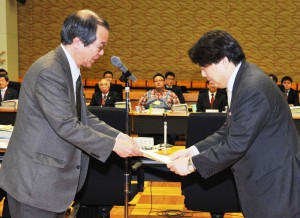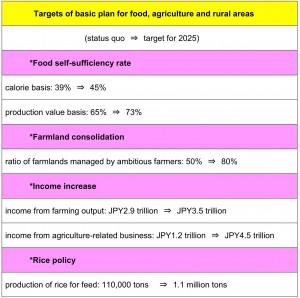The Council of Food, Agriculture and Rural Area Policies submitted a new ten-year basic plan for food, agriculture and rural areas to agriculture minister Yoshimasa Hayashi on Tuesday, March 24, which includes a goal of increasing the nation’s calorie-based food self-sufficiency rate to 45 percent from the current 39 percent.

Shinichi Shogenji (left), head of the Council of Food, Agriculture and Rural Area Policies, hands a basic plan for agricultural policies to farm minister Yoshimasa Hayashi at the agriculture ministry on Tuesday, March 24.
The panel, headed by Prof. Shinichi Shogenji of Nagoya University’s Graduate School of Bioagricultural Sciences, presented numerical targets for the government’s agricultural policies, such as expanding production of rice for feed, consolidating farmlands to be managed by large-scale, ambitious farmers and increasing farmers’ income.
The plan, which is revised every five years, is expected to be approved by the Cabinet by the end of this month. It will be the first revision of the plan under the current administration.
“Since production of rice for feed is currently under economic and technological review, it is important to verify the plan at different stages,” said Ajinomoto Co. Chairman Norio Yamaguchi, a member of the panel.
The government should “strengthen measures to promote rural villages by taking into consideration different conditions according to regions,” said another member Tsugihiro Watanabe, professor of Kyoto University’s Graduate School of Global Environmental Studies.
Hayashi replied: “We will make an all-out effort to reform policies based on the new basic plan, and work on creating strong agriculture and beautiful and vigorous rural villages, so that people, especially the young, will be encouraged to have aspirations.”
The panel proposed revising the target for calorie-based food self-sufficiency rate to 45 percent from the current 50 percent in order to make it more feasible. Meanwhile, it suggested raising the target on a production value basis from the current 70 percent to 73 percent, by focusing on boosting production of vegetables and livestock which can contribute more to increasing output in terms of value.
It also calls for measures to encourage farmers to shift from production of rice for staple food, whose consumption is declining, to rice for feed. It sets a target of expanding production of rice for feed tenfold to 1.1 million tons in 2025 through strengthening assistance.
 Regarding farmland consolidation, the panel proposes increasing the ratio of farmlands managed by so-called “ambitious” farmers – municipal-certified farmers, community-operated agriculture and certified beginning farmers – to 80 percent of total farmlands from the current 50 percent.
Regarding farmland consolidation, the panel proposes increasing the ratio of farmlands managed by so-called “ambitious” farmers – municipal-certified farmers, community-operated agriculture and certified beginning farmers – to 80 percent of total farmlands from the current 50 percent.
The government will work on implementing measures to double farmers’ income in the coming ten years, as stated in its plan to revitalize agriculture, forestry and fisheries industries and rural areas. However, since it will be difficult to largely increase income from farming alone, the key areas of growth would be other businesses such as processing and marketing of farm products, exports, exchanges with urban areas and renewable energy production. It will become necessary to raise awareness of the new strategy among farmers.
<Analysis>
Government should cooperate closely with farmers
The new basic plan for food, agriculture and rural areas was put together as the nation’s population turned to a declining trend for the first time. It strongly reflects a sense of danger that the aging agriculture industry, hit by lack of successors, is quickly weakening and needs to be tackled in the next decade.
Fostering successors is a pressing issue. Moreover, shrinking population changes the consumption trend. It will be hard to meet the goal of expanding farmers’ income amid predicted decrease in demand for various farm items. The basic plan will end up being a pie in the sky unless governmental assistance effectively backs up farmers’ efforts.
Demand for rice for staple food is already decreasing by 80,000 tons every year, prompting the government to shift its rice policy to boost production of rice for feed. The new basic plan sets a target of increasing production of rice for feed to 1.1 million tons in ten years and hammers out assistance measures so that farmers can make long-term plans.
Demand for livestock, fruit, wheat and soybeans are also predicted to decline. New strategies are needed to revitalize the industry, including taking back market share from imports, increasing income by adding value, seeking new demand overseas and shifting to new crops and varieties.
Such measures will be effective only if the government can provide an environment where farmers’ efforts are rewarded. The government should draw lessons from the fact that its rice policy, which is the main pillar of agricultural policy reform, ended with a decline in rice prices in the first year. It must first come up with a system that stabilizes farmers’ business, and closely communicate with farmers to set out a clear vision for the future of agriculture.
(March 25, 2015)

